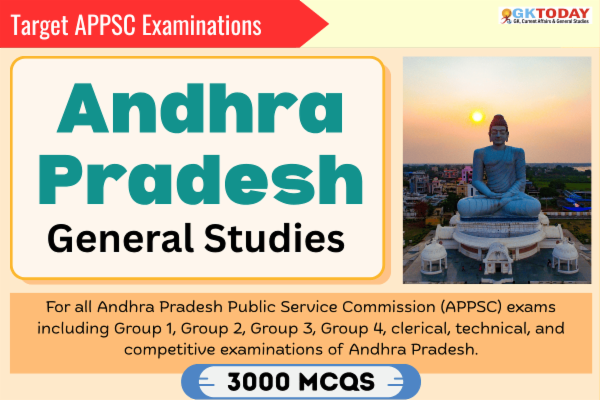States PCS: Andhra Pradesh GK For APPSC Examinations
For all Andhra Pradesh Public Service Commission (APPSC) exams including Group 1, Group 2, Group 3, Group 4, clerical, technical, and competitive examinations of Andhra Pradesh.
41. Who succeeded Joseph François Dupleix in overseeing the French affairs in the Deccan region in 1754?
[A] Charles Bouchier
[B] Hyder Ali
[C] Jean Law
[D] Marquis de Bussy-Castelnau
Show Answer
Correct Answer: D [Marquis de Bussy-Castelnau]
Notes:
Marquis de Bussy-Castelnau succeeded Dupleix in 1754, managing French military and political operations in the Deccan and forging key alliances, notably with the Nizam of Hyderabad.
42. Which of the following dynasties is considered one of the major early rulers of Andhra Pradesh?
[A] Ikshvaku
[B] Salankayana
[C] Satavahana
[D] Kalinga
Show Answer
Correct Answer: C [Satavahana]
Notes:
The Satavahanas (c. 3rd century BCE–3rd century CE) were the earliest major dynasty of Andhra, with capitals at Pratishthana. They traded with the Roman Empire, issued lead coins, and patronised the Amaravati stupa.
43. Which city served as the capital of the Ikshvaku dynasty from 225–300 CE?
[A] Amaravati
[B] Vijayapuri
[C] Dhanyakataka
[D] Bezawada
Show Answer
Correct Answer: B [Vijayapuri]
Notes:
Vijayapuri (present-day Nagarjuna Sagar) was the Ikshvaku dynasty capital, known for Buddhist sites, Mahayana art, and administrative inscriptions.
44. Which deity did the Salankayana dynasty declare themselves devotees of during their rule over coastal Andhra Pradesh?
[A] Govindaraja
[B] Bappa Bhattaraka
[C] Tripurantakeshwara
[D] Amaralingeswara
Show Answer
Correct Answer: B [Bappa Bhattaraka]
Notes:
The Salankayanas were devotees of Bappa Bhattaraka, a Shaiva deity, as evidenced by their copper-plate grants and temple patronage in coastal Andhra Pradesh.
45. During the Salankayana dynasty’s rule in northern Andhra Pradesh (3rd–6th centuries CE), which language replaced Prakrit as the official language of administration and inscriptions?
[A] Telugu
[B] Pali
[C] Sanskrit
[D] Kannada
Show Answer
Correct Answer: C [Sanskrit]
Notes:
Sanskrit replaced Prakrit as the official language under the Salankayanas, as seen in royal inscriptions and edicts, marking a key linguistic shift in Andhra Pradesh’s history.
46. Who was Munyada as mentioned in the 7th-century Eluru inscription found at Pedda Venkatachalam?
[A] An ancient merchant guild leader in Kalinga under the Satavahanas
[B] A regional administrator in Telangana during the Rashtrakuta period
[C] A noted temple architect in Rayalaseema under the Cholas
[D] A high-ranking royal functionary under Eastern Chalukya king Jayasimha I in Andhra Pradesh
Show Answer
Correct Answer: D [A high-ranking royal functionary under Eastern Chalukya king Jayasimha I in Andhra Pradesh]
Notes:
The Eluru inscription records Munyada as Mantristhana-pradhana, a minister under Jayasimha I of the Eastern Chalukyas, overseeing administration and land grants in early medieval Andhra Pradesh.
47. Who was the son of Prola Raju, known for serving as a feudal lord under the Kakatiya rulers and reinforcing the defenses of Warangal?
[A] Vema Raju
[B] Betha Raju II
[C] Rudra Raju
[D] Dora Raju
Show Answer
Correct Answer: B [Betha Raju II]
Notes:
Betha Raju II, son of Prola Raju, was a key Kakatiya-era feudal lord at Warangal (c. 1280–1323 CE), known for his military, administrative, and cultural contributions in medieval Andhra Pradesh.
48. In a celebrated poetic debate, whom did the 15th-century Telugu poet Srinatha defeat, thereby gaining immense acclaim and royal patronage?
[A] Potana
[B] Annamacharya
[C] Dindima Bhattu
[D] Tenali Ramakrishna
Show Answer
Correct Answer: C [Dindima Bhattu]
Notes:
Srinatha defeated Dindima Bhattu, the esteemed court poet of Vijayanagara ruler Devaraya II, enhancing his prestige and influence in Telugu literature.
49. Which significant discovery at Nagarjuna Konda in Andhra Pradesh highlights its ancient trade relations with the Roman Empire?
[A] Inscriptions of Mauryan Emperor Ashoka
[B] Ancient Tamil Sangam literature manuscripts
[C] Chola dynasty gold jewelry
[D] Over 20,000 Roman silver and bronze coins
Show Answer
Correct Answer: D [Over 20,000 Roman silver and bronze coins]
Notes:
Archaeological excavations at Nagarjuna Konda yielded more than 20,000 Roman silver and bronze coins (1st century BCE–4th century CE), indicating extensive trade with the Roman Empire and the site’s importance as a commercial and Buddhist center.
50. Who was the first Speaker of the Andhra Pradesh State Legislative Assembly?
[A] Ayyadevara Kaleswara Rao
[B] Pamula Subba Rao
[C] N. G. Ranga
[D] Behara Seshagiri Rao
Show Answer
Correct Answer: A [Ayyadevara Kaleswara Rao]
Notes:
Ayyadevara Kaleswara Rao was the first Speaker of the Andhra Pradesh Legislative Assembly, serving from November 1, 1953 to March 31, 1955, following the creation of Andhra State.

